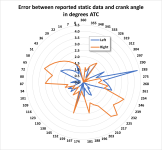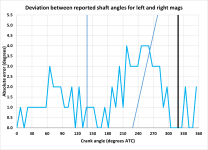LouNathanson
I'm New Here
Ever since I installed a second pMag, my EI Commander occasionally reports a shaft angle mismatch during its startup check of static (non-running) data. It only occurs when the prop is in a certain narrow range that is far from the actual firing points (which are in the vicinity of 0 and 180 degrees). The error is consistent at that particular crank angle range, and looks like this:

Shaft angle alert2016×1512 266 KB
Since the two pMags line up within a degree near the actual firing points, this doesn’t seem to affect operation, and my running timing deviation angle indication (TDA) is always about 2 degrees. In flight mag checks look good.
The right mag seems to be the main culprit, and this apparent distortion in the triggering magnet’s field seems to persist despite three IRANs performed by the Emag folks. Brad at Emag insists that this is nothing to worry about and that a comparison of static angle data is meaningless far away from 0 or 180 degrees.
However, the EI Commander folks are not comfortable moving the alarm point to any greater than 4 degrees of deviation because they say I’m the only one that has a static deviation this large. My inner pilot hates to take off with an error indication, but I’m kinda stuck between dueling vendors.
So, my question for the group is: Does anyone else that is running dual pMags with an EI Commander ever get this error?

Shaft angle alert2016×1512 266 KB
Since the two pMags line up within a degree near the actual firing points, this doesn’t seem to affect operation, and my running timing deviation angle indication (TDA) is always about 2 degrees. In flight mag checks look good.
The right mag seems to be the main culprit, and this apparent distortion in the triggering magnet’s field seems to persist despite three IRANs performed by the Emag folks. Brad at Emag insists that this is nothing to worry about and that a comparison of static angle data is meaningless far away from 0 or 180 degrees.
However, the EI Commander folks are not comfortable moving the alarm point to any greater than 4 degrees of deviation because they say I’m the only one that has a static deviation this large. My inner pilot hates to take off with an error indication, but I’m kinda stuck between dueling vendors.
So, my question for the group is: Does anyone else that is running dual pMags with an EI Commander ever get this error?






